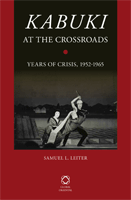| SANSHď-DAY█ |
| Play titles | Yura no Minato Sengen Ch˘ja Sansh˘-dayű Kogane no Toridoshi |
|||||||||
| Common title | Sansh˘-dayű |
|||||||||
| Authors | Chikamatsu Hanji Miyoshi Sh˘raku Takeda Koizumo II |
|||||||||
| History |
The play "Yura no Minato Sengen Ch˘ja" was originally written for the puppet theater (Bunraku) and staged for the first time in the 5th lunar month of 1761 in ďsaka at the Takemotoza. It was adapted for Kabuki the next year and staged for the first time in 1763 in ďsaka at the Sonezaki Shinchi Minami no Shibai (not an ˘shibai venue). It was staged for the first time in ˘shibai, in ďsaka in the 5th lunar month of 1784 at the Kado no Shibai [casting]. It was premiered in Edo only in the 7th lunar month of 1837, at the Ichimuraza under the title "Sansh˘-dayű Kogane no Toridoshi" [casting]. The story of "Yura no Minato Sengen Ch˘ja" was based on the legend of Sansh˘-dayű (the tayű Sansh˘), an old and famous sekky˘-bushi. The way to write Sansh˘ in "Yura no Minato Sengen Ch˘ja" was not the classic writing but it used the ideograms for 'three' (san) and 'villa' (sh˘):
It meant that Sansh˘-dayű was the owner of three magnificent and prosperous villas in Hashidate, Nariai and Yura [1]. In modern times, "Yura no Minato Sengen Ch˘ja" was revived only twice during the 1950s. Here is the list of all performances in ˘shibai from the end of WWII to 1959: |
|||||||||
|
||||||||||
| Structure |
"Yura no Minato Sengen Ch˘ja" was in 5 acts. |
|||||||||
| Key words |
Bukkaeri Ch˘ja Echigo Gidayű Ky˘gen Hanami Hashidate Hitokai Inga Maruhonmono Modori Nariai ďshű R˘nin Sekky˘-bushi Seppuku Tango Tori Musume Yura |
|||||||||
| Summary |
Iwaki Hangan Masauji, head of the Iwaki family of ďshű, has been assassinated by a r˘nin because of the ambitions of Tokikado, Lord of ďe. Masauji's wife, Mutsuki-no-Kata [2], accompanied by the faithful retainer Motoyoshi Kanamenosuke, flees with their children, Princess Anju and Zushi˘maru. The loyal Iwaki retainer ďwada Kuranoshin commits suicide (seppuku) because of his master's death. Mutsuki-no-Kata gets as far as ďgi Bridge in Echigo, where she is separated from her offspring by a slave dealer. The slaver Yamaoka Gonroku is an old Iwaki retainer who is trying to raise money to form an army in hopes of restoring the Iwaki clan, and does not recognize the family he is splitting up. Mutsuki-no-Kata is sent to Sado Island, and the children are sold to Master Sansh˘ (or Sansh˘ the bailiff), the very r˘nin who murdered Masauji. He has become an avaricious millionaire who gets his name, meaning "Three Villas," from the homes in different places in Tango with which he has been rewarded by Tokikado. The children, now called Nobuo and Wasuregusa, are engaged in back-breaking labor on his property in Yura Bay, where they haul salt from the sea and cut grass, being tortured if they complain. Kanamenosuke visits the youngsters in hopes of saving them, but is captured by Sansh˘'s nephew, Yura no Sabur˘. Recognized as an Iwaki, he is sentenced to death by beheading, along with the siblings, when the first cock crows at dawn. Osan, Sansh˘'s daughter-in love with Kanamenosuke, whom she once met at a flower viewing-is, because of her father's bad karma (inga), afflicted with a disease that causes her to be transformed into a fowl before dawn, when she flaps her wings and crows. She is thus called Tori Musume or "Chicken Girl." There is a saying that if you buy one thousand white chickens, your daughter will become empress, but in the present case, Sansh˘ has bought one thousand chickens in hopes of hiding his daughter's strange ailment. She hopes to save Kanamenosuke's life by preventing her father's thousand chickens from crowing, and runs around killing them, but cannot prevent herself turning into one of them and crowing. She chews Kanamenosuke's ropes off and then kills herself. The children are set free and escape, and the samurai confronts Sansh˘. The latter, however, recognizes him as the child who was stolen from him years ago and realizes that Masauji was his own master. Repenting of the crimes that he has committed (modori), he allows his long-lost son to kill him. Kanamenosuke takes his own life to atone for having slain his father. The children head for Sado, where they are reunited with their mother. The highlight comes with the vision of the mad Osan in the form of a fowl, a transformation effected largely by the use of a costume, revealed via bukkaeri, on which a unique feathered pattern has been dyed. The subject of a woman turned into a bird resembles that of "Sagi Musume".
|
|||||||||
| Notes |
[1] A few characters in this drama had a name linked to these 3 places : Yura no Sabur˘, Hashidate no Gor˘ and Nariai no Tar˘. [2] Mutsuki-no-Kata or Kita no Kata. |
|||||||||
 |
|
|
An illustration from the ezukushi banzuke for the staging of the drama "Yura no Minato Sengen Ch˘ja" in the 5th lunar month of 1784 in ďsaka at the Kado no Shibai with Kagaya Kashichi I (top), Mihogi Gizaemon II (bottom/left) and Yamashita Kamenoj˘ IV (bottom/left) in the roles of the tayű Sansh˘, Yamaoka Gonroku and Sansh˘'s musume Osan |
|
|
|
| Contact | Main | Top | Updates | Actors | Plays | Playwrights | Programs | Links | FAQ | Glossary | Chronology | Illustrations | Prints | Characters | Derivatives | Theaters | Coming soon | News |

